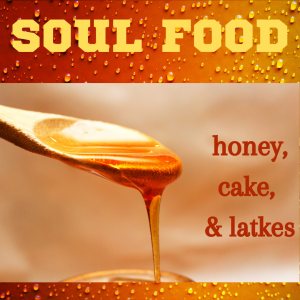 Do you consider recipes thought-provoking? Have you ever read a cookbook from cover to cover? Can one really cry over a recipe collection?
Do you consider recipes thought-provoking? Have you ever read a cookbook from cover to cover? Can one really cry over a recipe collection?
Honey Cake & Latkes: Recipes from the Old World by Auschwitz-Birkenau Survivors is one that you may read at one sitting and it might make you reach for a tissue rather than a wooden spoon. Initiated, solicited, and published by the Auschwitz Birkenau Memorial Foundation, a new collection of 110 Eastern European recipes is more than just a typical cookbook. In addition to recipes of food that helped Holocaust survivors to cope during and after their ordeal, this food memoir also shares their histories and memories of all that they have been coping with ever since.
 Art and literature are known to have the power to help relive past events, which, in turn, can lead to a better understanding of the present, including the present self. Memories, sensations, and thoughts, often triggered by the smallest details, pave the path for bibliotherapy and art therapy to work for the individual and a group.
Art and literature are known to have the power to help relive past events, which, in turn, can lead to a better understanding of the present, including the present self. Memories, sensations, and thoughts, often triggered by the smallest details, pave the path for bibliotherapy and art therapy to work for the individual and a group.
While cookie-cutter solutions are few and far between in literature, the most famous metaphor to evoke strong feelings is in fact a small, shell-shaped cookie, a madeleine, introduced to literature by French writer Marcel Proust in volume one, Swann’s Way, of his novel In Search of Lost Time. When the protagonist arrives home chilled in the cold winter weather, the cookie his mother offers triggers an unexpected feeling (click image to read the excerpt).
From Honey Cake & Latkes: Recipes from the Old World by Auschwitz-Birkenau Survivors we learn that not only the taste or smell of food can bring back memories, but memories of the food will bring back more memories. “Food and aroma instantly bring back memories. Sometimes, memory is all that is left of the people we loved dearly,” as Ronald S. Lauder, the son and heir of Estée Lauder, writes in the Foreword. “This book has memory. It also has incredible recipes from some special people close to my heart.”
 Lauder, the chairperson of the Auschwitz-Birkenau Memorial Foundation, was inspired by a recent visit in Poland for the 75th commemoration of the liberation of Auschwitz, where he had the chance to talk with many of the 120 elderly survivors visiting the place at the anniversary. He made an amazing discovery, as he recalls in the Foreword: “In our conversations, something interesting came out. Of all things, we started talking about the recipes they remembered from their childhood and the recipes they brought to the U.S.”
Lauder, the chairperson of the Auschwitz-Birkenau Memorial Foundation, was inspired by a recent visit in Poland for the 75th commemoration of the liberation of Auschwitz, where he had the chance to talk with many of the 120 elderly survivors visiting the place at the anniversary. He made an amazing discovery, as he recalls in the Foreword: “In our conversations, something interesting came out. Of all things, we started talking about the recipes they remembered from their childhood and the recipes they brought to the U.S.”
During the pandemic lockdown people started to cook at home more often, learning how to cook from books and the Internet, exploring new recipes. The ones collected for this book are special. Research and data gathering meant reaching out to survivors for recipes, which resulted in many Jewish favorites such as blintzes, matzo ball soup, and latkes, including Jewish holiday food such as challah and many Hungarian favorites, such as goulash, plum dumplings. stuffed cabbage, and palacsinta (blintzes or Hungarian pancakes).
You may find the same recipes, or their variations, on the Internet or in other cookbooks too. What really sets these apart is the story behind each heirloom recipe, as the proof of the potential in food to preserve hope and to make the first move toward healing.
In addition to sharing and preserving recipes, the book also shares contributing Holocaust survivors’ memories before the war and after the camps were liberated, all from the perspective of food, cooking, and their role to connect generations over time. Each contributor has their own profile page with their own heartbreaking stories. Forty images on six pages picturing entire families or individuals of various ages set the tone that this recipe collection honors families who suffered unimaginable loss and pain.
One of the contributors is Marion Weisel, widow of the late Nobel Laureate, professor, and activist, Elie Weisel, sharing her husband’s latke recipe in the last chapter, never published before. Latkes, or potato pancakes, are probably one of the most famous Jewish foods, consumed also on any holiday and for any occasion. The secret in the Weisel-recipe is that they never add onion or garlic to the mix!
Forgotten recipes from the “old country” are precious in each culture. This collection is the result of a worthy project: personal histories revealing world history through food that heals.
Even if you’re not interested in cooking and recipes, these mouthwatering images may inspire you try some of the best Eastern European cuisine. The recipes are easy to follow (often with ingredients adapted to current availability), the food prep is not time-consuming, and most of the dishes are healthy. You should give it a try. You never know, they just might as well bring comfort and joy to your family too.
Take it from Ronald S. Lauder: “And when you put these beautiful dishes on the table, remember they are also served, as every Jewish mother serves everything she makes, with a large portion of love.”